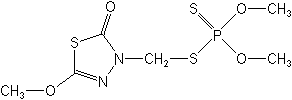-
Common NameMethidathion
-
中文通用名杀扑磷
-
IUPACS-2,3-dihydro-5-methoxy-2-oxo-1,3,4-thiadiazol-3-ylmethyl O,O-dimethyl phosphorodithioate
or
3-dimethoxyphosphinothioylthiomethyl-5-methoxy-1,3,4-thiadiazol-2(3H)-one -
CASS-[(5-methoxy-2-oxo-1,3,4-thiadiazol-3(2H)-yl)methyl] O,O-dimethyl phosphorodithioate
-
CAS No.950-37-8
-
Molecular FormulaC6H11N2O4PS3
-
Molecular Structure
-
Category
-
ActivityInsecticide, acaricide
-
Physical PropertiesMolecular weight:302.3; Physical form:Colourless crystals. Density:1.51 (20 °C) ( OECD 109); Melting point:39-40 °C; Vapour pressure:2.5 ×10-1 mPa (20 °C); Henry constant:3.3 × 10-4 Pa m3 mol-1 ( calc.); Partition coefficient(n-octanol and water):logP = 2.2 ( OECD 107); Solubility:In water 200 mg/l (25 °C). In ethanol 150, acetone 670, toluene 720, hexane 11, n-octanol 14 (all in g/l, 20 °C).; Stability:Rapidly hydrolysed in alkaline and strongly acidic media; DT50 (25 °C) 30 min at pH 13. Relatively stable to hydrolysis in neutral and slightly acidic media.;
-
ToxicologyOral:Acute oral LD50 for rats 25-54, mice 25-70, rabbits 63-80, guinea pigs 25 mg/kg. Percutaneous:Acute percutaneous LD50 for rabbits 200, rats 297-1663 mg/kg. Non-irritating to eyes and skin (rabbits). Not a skin sensitiser (Buehler test). Inhalation: LC50 (4 h) for rats 140 mg/m3 air.
-
Environmental ProfileEcotoxicology:
Algae: EC50 (72 h) for Scenedesmus subspicatus 22 mg/l.Bees:Slightly toxic to bees.Birds:Acute oral LD50 for mallard ducks 23.6-28 mg/kg. LC50 (8 d) for bobwhite quail 224 ppm.Fish: LC50 (96 h) for rainbow trout 0.01, bluegill sunfish 0.002 mg/l.Worms: LC50 (14 d) for earthworms 5.6 mg/ kg soil.Other beneficial spp.:To be rated as detrimental to most beneficial arthropods in the short term. It has a limited surface residual effect which allows a re-immigration of beneficials from untreated parts.
Environmental fate:
Animals:In mammals, methidathion is rapidly metabolised and excreted.Soil:Methidathion and its metabolites have a low mobility in soils. The compound is rapidly degraded in soil and water by chemical, photolytic and biological processes. DT50 3-18 d (laboratory and field results).Plant:In plants, rapid metabolism occurs. The overall metabolic pattern indicates hydrolysis of the ester bond, cleavage of the heterocyclic moieties into fragments which are further oxidised to CO2. -
Transport InformationSignal Word:WARNING; Hazard Class:II(Moderately hazardous)
Porduct NewsMore
Orthosulfamuron boosts sugarcane production, study finds
Glyphosate price plummets 40% in one year in Argentina
Indian govt stops imports of herbicide Glufosinate priced below Rs 1,289 per kg
Carbendazim fungicide wins victory in Brazilian Parliament
Corteva presents new pre-emergent herbicide Linear for sugarcane in Brazil
Picloram Triclopyr Aminopyralid
Revolutionizing disease prevention: BASF launches new rice fungicide Cevya® in China
Thiamethoxam is allowed again in Brazil by a judicial decision
Bayer develops alternative to glyphosate herbicide
Related CompaniesMore
Qingdao Hansen Biologic Science Co., Ltd.
Country: China
Fomesafen Acifluorfen Lactofen Trifluralin Quizalofop-P-ethyl Propargite Methidathion Thifluzamide Oxyfluorfen
Country: China
Fipronil Spirodiclofen Florasulam Desmedipham Phenmedipham Ethofumesate Glufosinate-ammonium Diquat dibromide Paraquat dichloride Pyraclostrobin

 0
0 Subscribe
Subscribe
